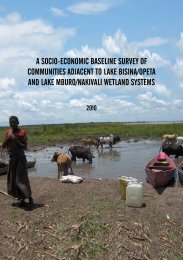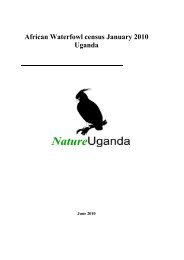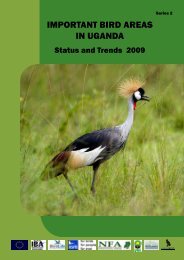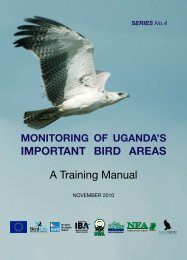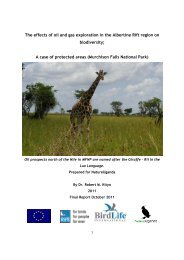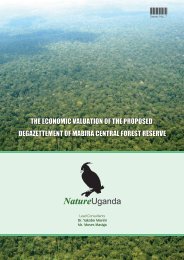A Ecological Baseline Surveys Of: - Lake Bisina - Nature Uganda
A Ecological Baseline Surveys Of: - Lake Bisina - Nature Uganda
A Ecological Baseline Surveys Of: - Lake Bisina - Nature Uganda
Create successful ePaper yourself
Turn your PDF publications into a flip-book with our unique Google optimized e-Paper software.
6.4 Indicator species for biodiversity monitoring<br />
At the moment it may turn out to be a rushed decision to point to any of the species in the list as<br />
potential indicator species. A more useful list would benefit from actual field surveys to establish the<br />
condition of the wetland systems, including among other:-<br />
i. Current nature of the vegetation<br />
ii. Land use schemes in the areas<br />
iii. Pressures and their sources onto the wetland systems<br />
In addition, such a survey would generate actual baseline data on occurrence of species, the<br />
distribution of the species and relative abundance of some common species. On the basis of these<br />
surveys, meaningful indicators would then be identified.<br />
In the meantime a simple monitoring scheme could involve: -<br />
i. Monitoring activity and diversity of insectivorous bats using a bat detector. This approach<br />
would quickly and cheaply yield baseline data through a passive monitoring scheme. These<br />
such data could be used to quickly gain impressions in communities dynamics of insect<br />
eating bats in the different areas<br />
ii. Transect runs to document large mammals or their signs to give insight into which species still<br />
range in the different areas<br />
iii. Trapping along the transects to document species and their relative abundance of the small<br />
mammals in the areas.<br />
These approaches will then help to collect data on the basis of which suitable indicator species can<br />
be selected. A detailed monitoring protocol would then be developed for these species. At the very<br />
minimum however the protocols will involve collecting data on among others:-<br />
i. Species presence or absence<br />
ii. Community composition trends<br />
iii. Seasonal variations in i and ii above<br />
iv. Trends in relative abundance and or dominance<br />
v. Total populations for such species for which this will be possible<br />
6.5 Next steps<br />
To verify the accuracy of the lists presented here, it will be essential to conduct detailed field surveys<br />
cognizant of the fact that mammal surveys for most of the orders are much slower and more time<br />
intensive exercises than vegetation and avian surveys. The surveys should target to acquiring<br />
primary field data but also secondary data from interviews with local communities.<br />
92<br />
<strong>Ecological</strong> <strong>Baseline</strong> <strong>Surveys</strong> of <strong>Lake</strong> <strong>Bisina</strong>, <strong>Lake</strong> Opeta, <strong>Lake</strong> Mburo and Nakivali Wetlands Systems



